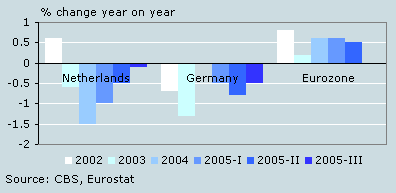Economic developments of the Netherlands and Germany differ from eurozone

Recent developments in the Dutch economy showed marked similarities with recent developments in the German economy. Between 2000 and 2004 the annual growth rates of the gross domestic products (GDP) of the two countries were very close. In the first three quarters of 2005 the development of Dutch GDP again closely resembled that of the German GDP. Inflation and developments on the job market also closely resembled each other in recent years. Producer confidence also followed similar trends since the second half of 2005. There is less of a resemblance between the Netherlands and the other Eurozone countries.
Economies intertwined
The economies of the Netherlands and Germany are intertwined. In 2004 almost a quarter of Dutch goods exports (in value) went to Germany. About one fifth of Dutch goods imports came from Germany. The Netherlands is Germany’s second import country and fifth export country. Moreover the Netherlands is the major transit country for Germany in which the port of Rotterdam plays a key role.
Economic recoveries in the Netherlands and Germany
The Dutch economy in 2005 was in a phase of recovery. In 2004 the relatively long economic downturn came to an end. The lowest point was halfway through 2003. The recovery of the Dutch economy is mainly due to exports. Moreover, throughout 2005 household consumption revived and the job market improved.
According to the Institut für Wirtschaftsforschung (IFO) in Munich, the German economy is likewise in a recovery phase after a period of stagnation in 2002 and 2003. The current recovery of the German economy is slow and seems dependent mainly on demand from abroad. The situation on the German job market, according to IFO, is sombre, in contrast to the Dutch situation (IFO, The state of the World Economy and the German Economy in the fall of 2005).
Few differences in economic growth
There have been minor differences in economic growth between Germany and the Netherlands since 2000. Annual GDP growth rates in the Netherlands and Germany were very close between 2000 and 2004. In 2005 the German and Dutch economies developed at the same pace. The economic growth rates of the Netherlands and Germany have been below the eurozone average in recent years.
In the late 1990’s the Dutch economy still grew considerably faster than the German economy. The Dutch Centraal Planbureau (CPB) attributes this to the negative economic effects of German unification and the economic reforms made in the Netherlands as deregulation of markets, tax cuts (CPB, CEP 2004).
GDP (market prices)

* Average of the three quarter changes
Similar developments in unemployment
Dutch developments in unemployment resemble those in Germany more closely than those in the eurozone. Between 2002 and the first quarter of 2005 the unemployment rates in the Netherlands and Germany, calculated by Eurostat, gradually increased. They started coming down again in the second and third quarter of 2005.
There are major structural differences between the Netherlands and Germany, however. The Dutch unemployment rate is about half that of Germany. According to the CPB the Netherlands has introduced job market reforms earlier, and more wide-ranging ones at that, than Germany has. This may have resulted in relatively positive employment developments.
Unemployment, harmonised

Job losses in both countries
The Netherlands has seen job losses in recent years. In 2003, 2004 and the first three quarters of 2005 the Netherlands on average had fewer employee jobs than the year before. This was also the case in Germany except for the year 2004. In the eurozone on the other hand, the number of employee jobs has been higher than the previous year for quite some time.
Number of employee jobs

Dutch and German inflation rates relatively low
The Dutch inflation rate in 2004 and 2005 was closer to the German than to the eurozone inflation rates. The inflation rates were below the eurozone average. Differences in the level and development between the German and Dutch inflation rates are due to the price war between the Dutch supermarkets. Inflation in the Netherlands in 2004 and 2005 was one of the lowest in the eurozone. In the period 1997-2003 Dutch inflation was higher than in Germany and the eurozone.
Inflation according to the European harmonised method (HICP)

Improved producer confidence in the two countries
Developments in producer confidence in Germany and the Netherlands also show similarities. Germany’s figures come from IFO, the Dutch figures come from the economic survey by Statistics Netherlands. The figures are available through December 2005. Producer confidence clearly improved in both countries in the second half of 2005. It remains to be seen if economic developments in 2006 will follow.